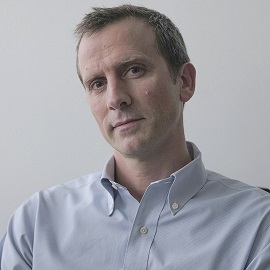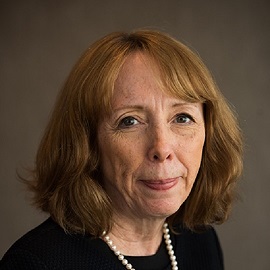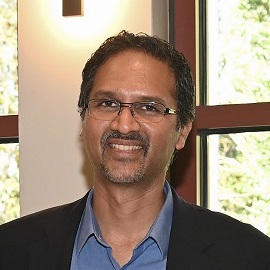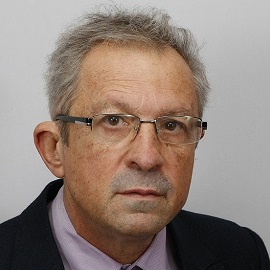Plenary Speakers

Inria, Ecole Normale Supérieure
Francis Bach
An alternative view of denoising diffusion models
Denoising diffusion models have led to impressive generative models in many domains.In this talk, I will present recent progress, with a focus on formulations that do not involve stochastic differential equations.
Short Bio
Francis Bach is a researcher at Inria, leading since 2011 the machine learning team which is part of the Computer Science department at Ecole Normale Supérieur. He graduated from Ecole Polytechnique in 1997 and completed his Ph.D. in Computer Science at U.C. Berkeley in 2005, working with Professor Michael Jordan. He spent two years in the Mathematical Morphology group at Ecole des Mines de Paris, then he joined the computer vision project-team at Inria/Ecole Normale Supérieur from 2007 to 2010.
Francis Bach is primarily interested in machine learning, and especially in sparse methods, kernel-based learning, neural networks, and large-scale optimization
He obtained in 2009 a Starting Grant and in 2016 a Consolidator Grant from the European Research Council, and received the Inria young researcher prize in 2012, the ICML test-of-time award in 2014 and 2019, the NeurIPS test-of-time award in 2021, as well as the Lagrange prize in continuous optimization in 2018, and the Jean-Jacques Moreau prize in 2019. He was elected in 2020 at the French Academy of Sciences. In 2015, he was program co-chair of the International Conference in Machine learning (ICML), general chair in 2018, and president of its board between 2021 and 2023; he was co-editor-in-chief of the Journal of Machine Learning Research between 2018 and 2023.

Professor and Division Chief, Molecular Imaging Program at Stanford (MIPS), Department of Radiology, Stanford University
Katherine Ferrara
Personalized imaging and theragnostics
Within this plenary lecture, we will focus on major biological and engineering advances that empower personalized theragnostics. Sonogenetic methods use genetically encoded, ultrasound-responsive mediators to control gene expression. In one aspect of our recent work, we engineered a hyper-efficient dCas12a and effector that can be activated in vivo through ultrasound absorption for gene activation or base editing. This strategy enabled multiplexed gene activation using a single guide RNA array. A key instrumentation advance for clinically viable translation of this work is volumetric control of ultrasound imaging and therapy, and therefore advances in 2D ultrasound arrays will also be detailed. Methods to transfect cells in vivo through viral and non-viral delivery are also critically important, and we will explore targeted lipid nanoparticles containing mRNA and engineered adeno-associated viruses (AAVs). In the application of AAVs, we use positron emission tomography (PET) imaging of gene expression to validate transduction of the brain with novel systemically-administered capsids. Through such non-invasive methods, we have tracked sustained transduction over more than one year and we will discuss the feasibility of human translation of brain transduction with engineered systemically-administered capsids. Finally, we will explore the exploding area of radiotheragnostics. Our team has employed spatial transcriptomics to identify target proteins for patient and molecularly-specific treatment of cancer. Based on these targets, small peptides have been engineered for highly sensitive imaging and for future theragnostics.
ShortBio
Katherine Ferrara, Ph.D., is a Professor of Radiology and the Division Chief for the Molecular Imaging Program at Stanford. She is a member of the National Academy of Engineering and a fellow of the IEEE, AAAS, the Biomedical Engineering Society, the World Molecular Imaging Society, the Acoustical Society of America and AIMBE. Following an appointment as an Associate Professor in the Department of Biomedical Engineering at the University of Virginia, Charlottesville, Dr. Ferrara served as the founding chair of the Department of Biomedical Engineering at UC Davis. Dr. Ferrara is known for work in the development of contrast agents and molecular imaging techniques and instrumentation. She has received the WMIS Gold Medal, IEEE Biomedical Engineering Award, IEEE Achievement Award and IEEE Rayleigh Award.

Professor of Biomedical Engineering; Departments of Pathology, Biomedical Informatics, and Radiology and Imaging Sciences at Emory University
Anant Madabhushi
Getting Serious about AI in Healthcare: Retrospective and Prospective Validation
While there continues to be a huge amount of interest in AI in medicine, relatively few of these approaches have been validated in retrospective or prospective clinical trials. In this talk I will discuss some of our ongoing work in validating AI algorithms in the context of radiology and pathology for precision medicine in the context of both completed and prospective ongoing clinical trials. I will discuss some of the challenges in blinded validation studies and some lessons learnt in prospective deployment and evaluation of these algorithms in the context of precision oncology.
Short Bio
Dr. Anant Madabhushi is the Robert W Woodruff Professor of Biomedical Engineering; and on the faculty in the Departments of Pathology, Biomedical Informatics, and Radiology and Imaging Sciences at Emory University. He is also a Research Health Scientist at the Atlanta Veterans Administration Medical Center. Dr. Madabhushi has authored more than 475 peer-reviewed publications and more than 100 patents issued or pending. He is a Fellow of the American Institute of Medical and Biological Engineering (AIMBE), and the Institute for Electrical and Electronic Engineers (IEEE) and the National Academy of Inventors (NAI). His work on “Smart Imaging Computers for Identifying lung cancer patients who need chemotherapy” was called out by Prevention Magazine as one of the top 10 medical breakthroughs of 2018. In 2019, Nature Magazine hailed him as one of 5 scientists developing “offbeat and innovative approaches for cancer research”. Dr. Madabhushi was named to The Pathologist’s Power List in 2019, 2020, 2021 and 2022.

Emeritus Research Director at Verimag
Joseph Sifakis
At present, there is a great deal of confusion as to the final objective of AI. Some see Artificial General Intelligence as the ultimate and imminent goal suggesting that it can be achieved through machine learning and its further developments.
We argue that despite the spectacular rise of AI, we still have weak AI that only provides building blocks for intelligent systems, mainly intelligent assistants that interact with users in question-answer mode.
A bold step toward human-level intelligence would be the advent of autonomous systems resulting from the marriage between AI and ICT envisaged in particular by the IoT. In this evolution, the ability to guarantee the trustworthiness of AI systems – reputed to be “black boxes” very different from traditional digital systems – will determine their degree of acceptance and integration in critical applications.
We review the current state of the art in AI and its possible evolution, including:
- Avenues for the development of future intelligent systems, in particular autonomous systems as the result of the convergence between AI and ICT;
- The inherent limitations of the validation of AI systems due to their lack of explainability, and the case for new theoretical foundations to extend existing rigorous validation methods;
- Complementarity between human and machine intelligence, which can lead to a multitude of intelligence concepts reflecting the ability to combine data-based and symbolic knowledge to varying degrees.
Short Bio
Joseph Sifakis is Emeritus Research Director at Verimag, a laboratory in the area of safety critical systems that he directed for 13 years. He has been a full professor at Ecole Polytechnique Fédérale de Lausanne (EPFL) for the period 2011-2016. Joseph Sifakis has made significant contributions to the design of reliable systems in many application areas, including avionics and space systems, telecommunications, and production systems. His current research focuses on autonomous systems, in particular self-driving cars and autonomous telecommunication systems. In 2007, he received the Turing Award for his contribution to the theory and application of model checking, the most widely used system verification technique. Joseph Sifakis is a member of six academies and a frequent speaker in international scientific and technical events.


